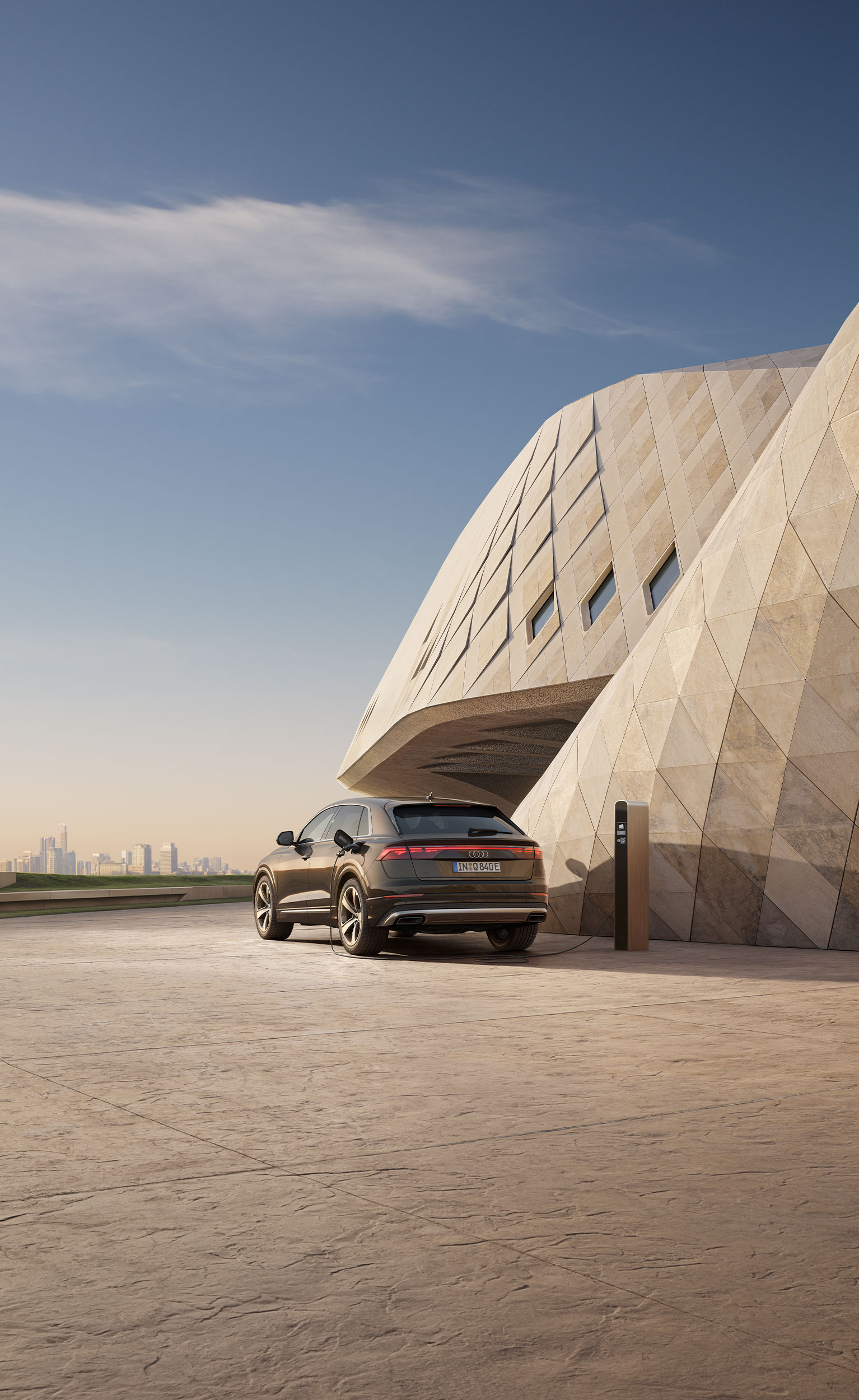
Q8 SUV TFSI e
75–85
km¹
5.0
s²
360
kW³
The result of being picky.
The Audi Q8 SUV TFSI e combines the best of both worlds: in all-electric mode it produces very little noise and zero local emissions. Despite the low noise level, the electric motor offers plenty of power. Thanks to recuperation during the journey, the system can recover electrical energy.
Elegant and impressive.
The gloss package with roof frame and window slot trims in anodised aluminium give the Audi Q8 SUV TFSI e a sporty look. The exterior mirror housings in body colour create an exclusive appearance.
Progressiveness transformed into light.
With HD matrix LED headlights with Audi laser light³ and digital OLED rear lights³, you can choose from four light signature pairs that create expressive light animation. The rear lights are equipped with proximity detection⁹ that activates all OLED segments of the stationary vehicle as soon as other road users approach.
Versatile and functional.
The generous interior offers plenty of space for five people. In addition, the battery for the electric motor is so compactly integrated below the loading area that a luggage capacity of up to 1,589 litres is produced when the seats are folded down.
The Audi Application Store in your Audi.
Use a selection of popular apps such as Spotify or YouTube directly in your vehicle’s MMI – without the roundabout way via a smartphone. With Alexa¹⁰, Amazon’s voice service, you can, for example, listen to the news, call up the weather forecast or sports events, stream music and plenty more besides.


Note: The image is from the Audi Q8 SUV.
Personal, not normal.
Fascinating photos or famous cinema heroes: simply select your favourite picture in your myAudi app⁸ under Themes³,¹⁴ and set it as the background image in the MMI. Eye-catching effect: the ambient lighting package plus³ automatically adjusts the colour mood to suit the motif.


Note: The image is from the Audi A6 Avant. Background in the MMI: © Thomas Hoepker - Magnum Photos
Ready for any driving situation.
Whether enhanced handling or sensible efficiency, off-road pleasure or towing a trailer load of up to 3.5 tonnes. The Audi Q8 SUV TFSI e will make an impact with its hybrid drive system and an exceptional performance.

All prices shown include VAT. Valid in Germany. Prices for other countries can be called up via the tariff details (see tariff overview) and via the myAudi app. The vehicle identification number is required to register your vehicle profile in the myAudi app. It has been possible to conclude a contract with Audi charging since 01/01/2023.
Amazon, Alexa and all related logos are trademarks of Amazon.com, Inc. or its affiliates. The Amazon Alexa app is available only in the following countries: Germany, Austria, UK, France, Spain, Italy and USA. An Amazon account is required for use. Amazon is responsible for the functions and content of Amazon Alexa. Certain Alexa functions are dependent on smart home technology. The system language of the MMI navigation plus with MMI touch response must be set to a language supported by Amazon Alexa integration. Please contact your Audi partner for further information on availability. The provision of access to Amazon Alexa is the responsibility of Amazon and can be guaranteed for no more than 3 years after purchase of the vehicle.
Use of holoride technology is restricted to the second row of seats.
The use of a 3D VR headset during the journey:
- is permitted exclusively for passengers in the second row of seats in the side seat positions
- is permitted for persons over 1.5 metres tall
- is only permitted if the 3D VR headset user cannot reach any object in front of them (e.g. the rear surface of the front seat) with their fully outstretched arm (including outstretched fingers);
- is only permitted if the necessary safety features (e.g. mounting device) are attached to the 3D VR headset
Further information on the holoride system can be found at www.holoride.com.













